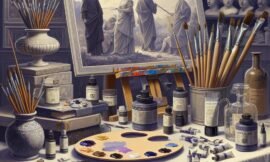Creating your own art studio at home is a rewarding endeavor that can elevate your artistic practice. Whether you are a budding artist or a seasoned creator, having a dedicated space allows you to unleash your creativity without the constraints of time or shared spaces. In this guide, we’ll walk you through the essential steps of organizing your studio space, selecting the right tools, and fostering an environment that inspires and supports your artistic journey.
Choosing the Right Space
Evaluating Your Needs
The first step in setting up your art studio is identifying what you need from the space. Consider the type of artwork you’ll be creating. Do you need expansive space for canvases or a cozy corner for digital art work? Reflect on activities that will take place in your studio such as painting, drawing, or perhaps digital design work. By assessing these needs, you can better tailor your studio to suit your artistic endeavors, ensuring maximum utility and comfort.
Space Considerations and Lighting
Once you understand your needs, find a room or area in your home that can accommodate them. Natural lighting is best for most art, so selecting a room with large windows can be beneficial. However, if natural light is scarce, investing in high-quality artificial lighting that mimics daylight can prevent eye strain and improve your ability to work with colors accurately.

Organizing for Efficiency
Strategic Layout
Once you have your space, organizing it efficiently will streamline your creative process. Start with the big pieces: your desk or easel and seating. Ensure these are positioned to maximize comfort and efficiency, with all necessary supplies within easy reach. Consider creating separate sections for different tasks such as a painting station, a sketching area, or a digital workstation.
Storage Solutions
Storage is often an overlooked aspect of studio setup but plays a vital role in sustaining your workflow. Use shelves and cabinets to store materials like paint, brushes, and canvas. For small items, transparent storage containers can keep supplies visible and organized while preventing clutter. Pegboards and drawer organizers are also excellent for keeping essential tools accessible while conserving space.
Essential Tools and Materials
Traditional Art Supplies
The tools you need will vary depending on your medium. Basic supplies for a traditional artist might include a variety of brushes, quality paints, a palette, canvases, and an easel. A sturdy drafting table can also serve as a multipurpose surface for both creating and planning your artwork. Brands like Winsor & Newton and Gamblin offer a breadth of high-quality painting supplies.
Digital Art Tools
Digital artists require a different set of resources. A high-performance computer, a reliable drawing tablet such as a Wacom or Huion, and software like Adobe Photoshop or Corel Painter are essential for digital creations. Ensuring that your setup supports ergonomic use is crucial for long sessions; consider investing in a desk chair or standing desk that promotes good posture.
Fostering an Inspirational Environment
Personal Touches
An inspirational studio environment can significantly impact your creativity. Personalize with pieces of art you admire, whether printed reproductions or original works. Display objects or textiles with vibrant colors and interesting textures to spark ideas. Surround yourself with a visual feast that motivates and sustains your artistic practice.
Comfort and Ambiance
Comfort is key for long hours of creativity. Consider adding a comfortable chair or lounge area for breaks. Setting the right ambiance with background music, scented candles, or even a small indoor plant can enhance focus and relaxation, allowing your creative process to unfold naturally. Remember, your studio should be a space where you feel free to experiment and grow.
Maintaining Your Studio
Regular Organization
To keep your art studio functional and inviting, regular maintenance is essential. Dedicate a few minutes at the end of each creative session to tidy up, organize materials, and replenish supplies if necessary. Consistent upkeep prevents clutter from accumulating and ensures an inviting workspace for future projects.
Updating Tools and Materials
Art supplies can wear out or become obsolete over time. Reviewing your inventory periodically allows you to replace worn or inadequate tools and experiment with new materials or mediums that might enhance your work. Keeping your toolset up-to-date and diverse encourages artistic innovation and helps you stay aligned with the latest art trends.
Connecting with Artistic Communities
Finding Inspiration
Art is a journey often enriched by community. Connecting with fellow artists, whether locally or online, can provide fresh perspectives and feedback that foster growth. Platforms like DeviantArt, Behance, and Instagram allow artists to world-share their work, and tools like Discord or Slack offer opportunities for real-time communication and collaboration.
Participating in Workshops and Events
Workshops, art fairs, and exhibitions are excellent opportunities to hone your skills and network with other artists. Attending these events, whether virtual or in person, can expose you to new techniques and provide inspiration that can be incorporated into your work. Engaging with the broader art world keeps your practice dynamic and alive.
Setting up your first art studio is a transformational step in any artist’s journey. By selecting a space that meets your needs and curating an environment rich in inspiration and efficiency, you lay the groundwork for an artistic practice that is both fulfilling and sustainable. Embrace the process of creating a special place that resonates with your creative spirit and grows alongside your evolving work.






